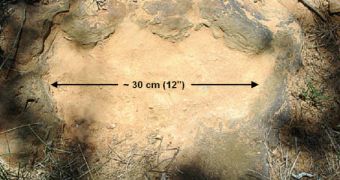A pawprint left behind by a low-slung nodosaur around 110 million years ago was recently discovered near the NASA Goddard Space Flight Center (GSFC), in Greenbelt, Maryland. Scientists say that the spiny leaf-eater was built like a tank, and very wary of predators.
Ray Stanford, a renowned dinosaur hunter, revealed the location of the indentations to GSFC officials and representatives from the Washington Post on Friday, August 17. He explained that the herbivore most likely sensed a predator, and quickened its steps, creating deep tracks in the Cretaceous mud.
“This was a large, armored dinosaur. Think of it as a four-footed tank. It was quite heavy, there’s a quite a ridge or push-up here. […] Subsequently the sand was bound together by iron-oxide or hematite, so it gave us a nice preservation, almost like concrete,” Stanford explained.
GSFC officials say that the markings are on a “sensitive, but unclassified” location. At this point, they are in talks with State of Maryland representatives and paleontologists about what to do with the footprint.

 14 DAY TRIAL //
14 DAY TRIAL //